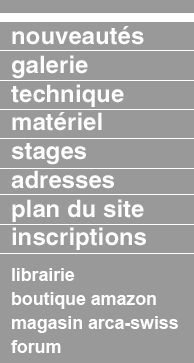A collection of autochrome plates
From 1916 to 1930
par Henri Gaud
Stereoscopic pairs 6x13 cm
Brought at a Drouot auction in Paris in 1977
The only indications are Port-Cros (April 1924) Nargis (November
1923) Rambouillet-Cernay (1924)
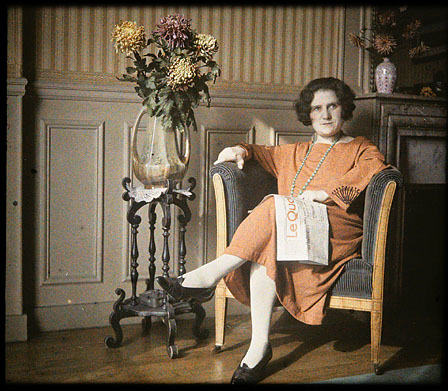
Our heroine : She does not look easy-going, probably her good
mood has vanished during WW-I. Interior shot. With a film of
sensitivity 1 ISO, exposure time was probably very long, this might
explain why she looks strained. Details on the newspaper are clearly
visible, but, too bad, no date in the field.
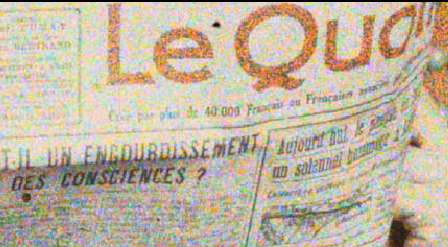
Details of the newspaper page. Potato starch grains are clearly
visible, but my feeling is that the blue, green and red coloured
starch grains interfere unpleasantly with the Bayer mosaic of my
Canon 1 Ds MkII sensor.

Technical details in highlights and shadows : D (HL)= 1.52 ; D (S)=
2.16.
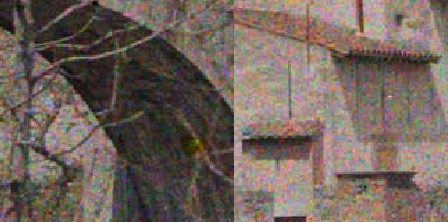

Our heroine again, probably on holidays. With a little training
you'll be able to see the relief of this stereoscopic pair. Those
6x13 shots are mounted between two glasses and can be examined with
a Planox stereoscope viewer, a semi-automatic device where the views
are carried to projector with a magnet.
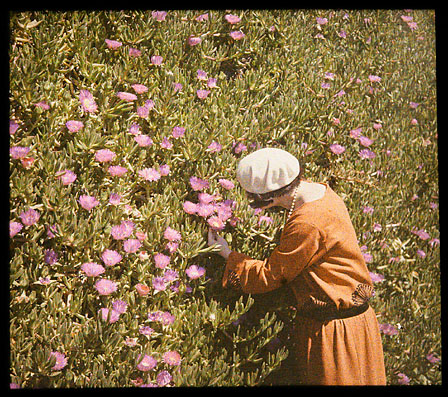
Our heroine : poetry of flowers, an eternal value ;-) Hue rendition
is very nice, colour separation is good, thanks to the trichrome
selection process in autochrome plates, saturations are at a good
level, despite the low contrast of the process, exposure is well
done probably thanks to the kind of "spotmeter" used at the time, a
"Justophot".
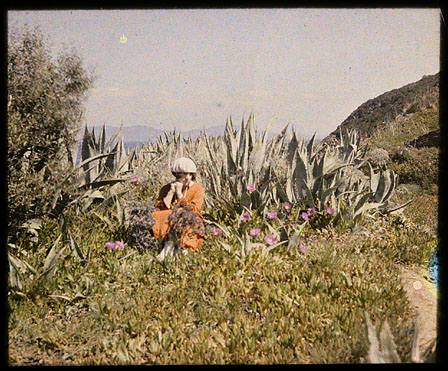
Our heroine poses in front of Mediterranean flowers & plants, image
rendition is still very interesting, no colour shifts, shadows are
very neutral, highlights are not burned, even the hat shows many
details.
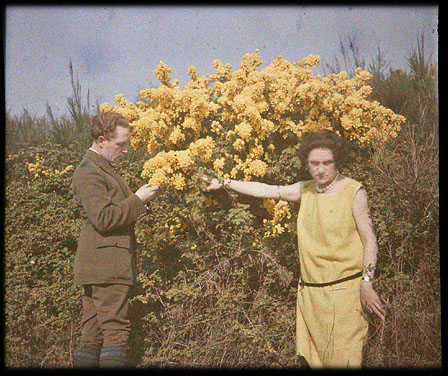
The ideal couple, the assortment of tones is rather funny, the lady
looks sulky, we should probably blame the strong direct sun light
for this attitude.
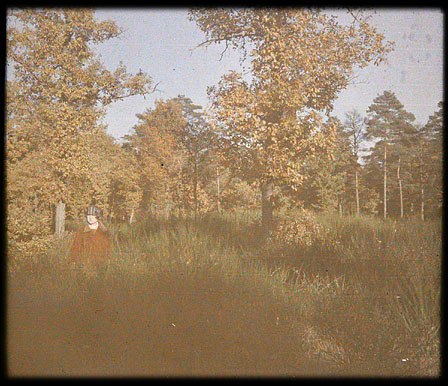
Probably a small technical problem, might be an under-exposure
corrected by an appropriate processing, or an attempt to apply the
Zone System before it was invented ; this could be possible with
this black and white film where the same silver halide layer manages
contrast for the three primary colours.
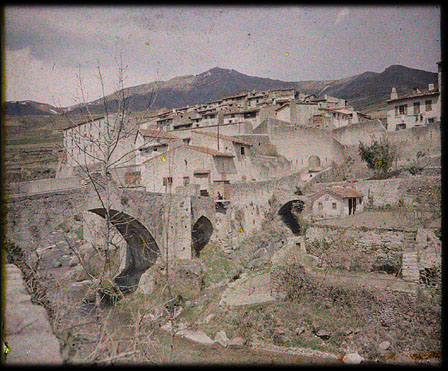
One may admire the rendition of fine details, highlight are very
clean, full of details, shadows are reasonably dense. Probably a
Mediterranean landscape not far from the coast.
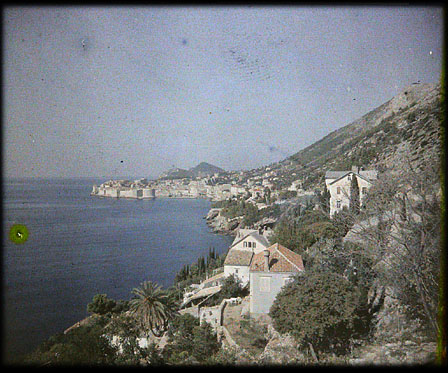
Here is the Riviera. Our photographer travelled by boat, this
collection is composed of about 500 stereo pairs, about forty of
them on autochrome plates. Our photographer's boat is often visible
on the images.

The boat is clearly visible in the distance, so this world is not a
poor men's world. Autochrome plates are quite expensive, even more
than black and white, autochrome photography is reserved to rich
photographers, a single autochrome plate costs as much as a full box
of B&W plates (12 glass plates per box at the time). Now the lady
needs a walking stick, time has elapsed, she is no longer in her
twenties...
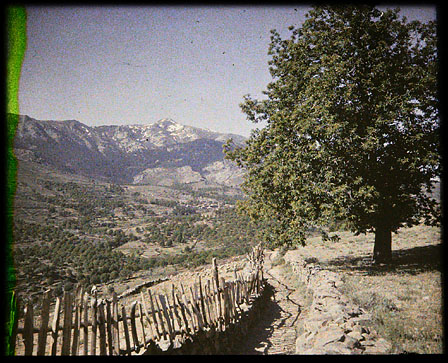
Green bands are typical problems that can arise with autochromes.
Potato starch grains do not age very well if the autochrome is not
protected from ambient air. Those stereoscopic autochrome plates
after processing have to be cut in two halves and re-mounted
sandwiched between another glass so that the stereo pair is in the
correct left/right viewing position. The whole sandwich is wrapped
inside a piece of black sticking paper, if everything goes well, the
autochrome will remain in good condition for decades, which is
surprising taking into account how strange the autochrome process
can be.
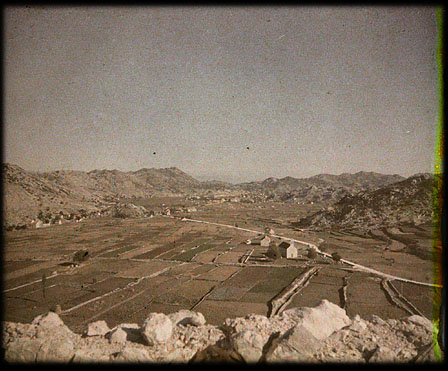
A typical view like stereoscopists loved them, looking for enhancing
visible stereo effects. The close foreground yields an incredible
feeling of depth when the autochrome is observed with the stereo
viewer.
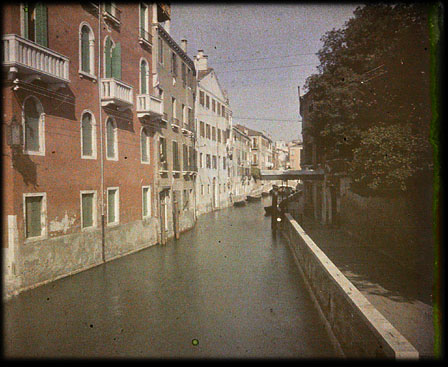
Venice, very probably, The story does not tell us if the
photographer could actually enter the city canals on board his boat,
probably yes, if we refer to other B&W pictures which tell us about
a long trip all around the Mediterranean sea. On this view, colours
look really faithful to true reality.
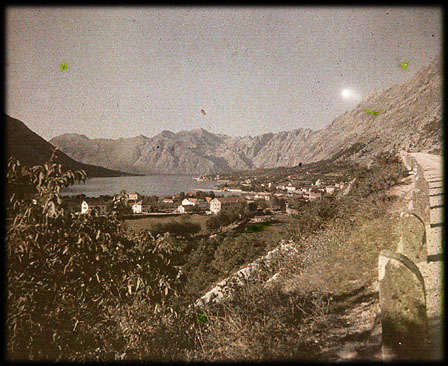
Those views have different tones, even if globally they are quite
homogeneous. In order to preserve the subtle differences, copies
have been made with a dedicated white balance by reference to a
light-box. The Planox stereo viewer was equipped with a "daylight"
illuminating system, in fact a conventional tungsten bulb strongly
corrected by a rather deep blue filter. Many details can be seen in
the shadows, and as far as where the picture has been taken, like
for other pictures of this collection, it is puzzle left to our
readers' sagacity.

A few hints to help identifying where the pictures were taken. Some
will suggest Corsica. Lighting conditions are not far from true back
lighting, nevertheless image rendition is very acceptable. For
decades, back lighting was the "pet hate" of amateur photographers;
neither vintage optics nor film could manage it properly. Exposure
is perfectly correct, one second at f/16 for 1 ISO equivalent
sensitivity, the famous "sunny-16" rule has been well tried and
tested for at least one century.
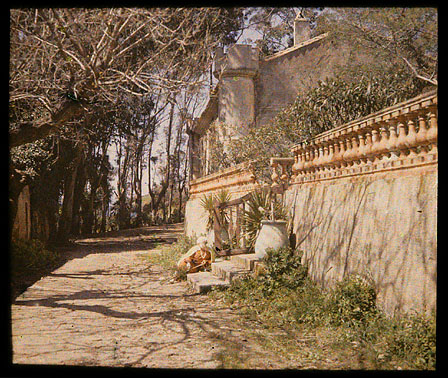
A well deserved rest after this long journey, comfortably sheltered
in this home decorated with somewhat ridiculous fake turrets, pure «
Côte d'Azur », typical Riviera-style, a more than questionable
architectural style ;-) Besides that, the place looks perfectly
charming. The camera should be well secured on a tripod when
exposure time is one to two seconds. Shadows are well detailed, as
well as highlights, by virtues of the winter Mediterranean sun and
flexibility of the autochrome process; may be a modern colour slide
film would not perform so well.

This is my favourite image in the series. This picture is perfect,
very good chromatic balance for an interior shot in available light.
I dare to say that we had to wait for modern digital photography in
order to manage mixed colour temperatures like autochromes did in
the past.
The "economy" page. Dates taken into account are 1930-2004. The
reference catalogue and price list for 1930 is Photo-Plait's, a
well-known Parisian photo store and mail order house at the time
(the store still existed in the 1980's). Autochrome plates were sold
per packs of four at a price of 13.10 French Francs (FRF) for each
4-pack of 6x13 cm plates. Processing and mounting stereo pairs was
charged 4.8 FRF per plate i.e. a total cost of about 8 FRF per
processed plate. The Planox stereo viewer was sold 1065 FRF in 1930.
The price for the Justophot "automatic" photometer was 175 FRF. The
price of the 6x13 Heidoscop camera with a 4.5 tessar lens and plate
holder cassette was 4100 FRF. The INSEE (French National Institute
for Statistics and Economy) price index suggests the following price
conversion rate : one FRF in 1930 is equivalent to 0.5 euro in 2004.
In terms of modern prices, the camera would cost 2670 euro, each
processed plate was charged 8 FRF at the time i.e. 4 euros in 2004.
If I can trust various informations gathered on the web, the salary
of a worker or employee in 1930 was equivalent to 4250 euros per
year, i.e. 350 euro per month.
Assuming that you are lucky enough to earn 3000 euros per month
today, if you convert the price for stereo + autochrome photographic
equipment in terms of months of your salary, the conversion yields
34 euros per plate and 23000 euros for the camera.
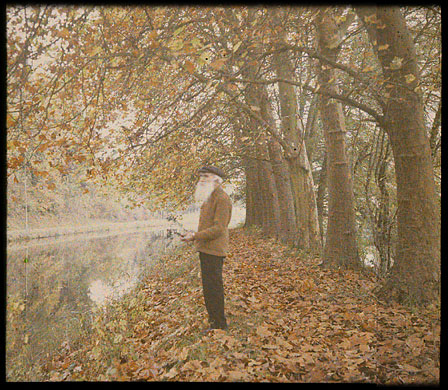
SOf course those attempts to convert old 1930 prices in terms of
modern 2004 economy are definitely questionable, However the
evaluations help us to understand the situation, and explain the
"natural" correlation between the photographer boat's size and the
cost of stereo autochrome photography presented in this collection.
Henri Gaud - 2005
traduit par Emmanuel Bigler
After the publication of this
article, Mr. Jorn Ake, one of our readers living in the United
States, has been able to identify several places where the images
have been taken. Many thanks to him.
M. Henri Gaud:
I am not certain if you have
already received this suggestion already, but I think the
stereographic autochromes that you have posted at the following url:
www.galerie-photo.com/autochrome_plate.html are
from a tour of Croatia. The bridge photographed is assuredly the
bridge at Mostar, recently rebuilt by the Bosnian government at some
expense. And the image further down, suggesting the Riviera, is
actually Dubrovnik seen from the south. The shot that suggests
Corsica is I believe Trogir or another of the seaside towns towards
Split (as I believe is the "Venetian" scene though I think that is
further north in a town in Istria called Rovinj, but I might be
mistaken here.) Additionally, the botanical photographs are from the
very extensive gardens to the north of Dubrovnik, gardens which only
exist in part any longer. At any rate, the photos are most likely
from a Croatian excursion (not uncommon even today to boat back and
forth across the sea from Italy to Croatia for a good fish meal!)
and given the hostilities there in the latter half of the twentieth
century, represent several areas which no longer look as these
photos represent. A nice document. Thank you.
Sincerely,
Jorn Ake
post-scriptum: I hope I am correct!
I think that I am on all except the Venetian- style photo, which may
in fact be Venice as Venice sits at the elbow between Croatia &
Italy. Perhaps these travelers circumnavigated the shores of the
Adriatic to reach Dubrovnik, stopping or originating in Venice. That
would be logical.
To see the stereoscopic pairs :
http://trichromie.free.fr/trichromie/index.php?post/2009/10/06/Allo-Tochrom
version française
dernière modification de cet article
: 2005
|
